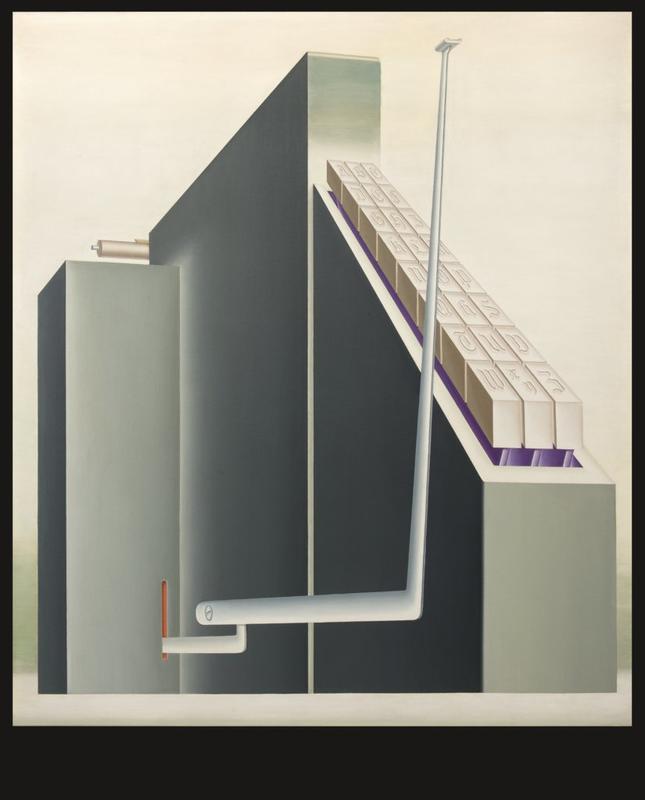More about The Legislator

Contributor
When it's all said and done, writes Rose-Maria Gropp in the Frankfurter Allgemeine newspaper in 2015, living legend Konrad Klapheck's paintings amount to a kind of "Intellektual-Pop, like the monarchic typewriter Der Gesetzgeber."
The title of this work is translated into English as The Legislator, but literally means The Lawgiver. "Legislator" is a word more familiar to English speakers, but conjures the image of a lawyer dressed in a suit, looking at an iPhone and drinking a coffee, while "lawgiver" is Exodus 24:8, where Moses sprinkles blood on people as "jewels" signifying the laws, and then later they lose their jewels when they worship a golden calf. The difference being that Klapheck's legislator is one who decides between right and wrong; he cites both Moses and Babylonian king Hammurabi as inspirations for this gargantuan typewriter.
The typewriter was the first machine Klapheck chose as a subject, when he was 20 years old in 1955 and studying at the Dusseldorf Art Academy, sparking a lifelong interest in depicting technology in this fashion. He would return to the typewriter time and time again throughout his career. The Legislator is one of a series of four typewriters anthropomorphized by their titles: The Boss (Der Chef), The Emperor (Der Herrscher), and The Dictator (Der Diktator), all powerful positions as the object reminds Klapheck of a throne. Though we're not sure if Germans also refer to the "long arm of the law," Klapheck states that the lever of the typewriter has specific significance to him, likening it to a scepter. This rendering merges a typewriter with a cash register, symbolizing the connection between industry and government in post-war Germany.
The owner of The Lawgiver, the Staedel Museum, tags this work with Franz Kafka's name, which is fitting as the author's work often deals with bureaucratic power. As Klapheck shares in recorded talks, he has cousins in the state of Israel, and when he was visiting them, he saw an object which would come to be the source of a painting. "What is that?", he asked his hosts. "A child's gas mask", they answered. "What a horror," Klapheck says. The horror of The Lawgiver is the Kafka-esque horror of the unmoving, imposing monolith of government, the bureaucratic system that won't budge when you need it to, or the bureaucracy which occupies territories by force, trades weapons, and destroys families - all in the name of the letter of the law.
Sources
- "A Conversation with Konrad Klapheck." Harvard Art Museums, Apr. 10, 2018, https://www.harvardartmuseums.org/article/a-conversation-with-konrad-kl….
- Artforum International 32. New York: Artforum International Magazine, 1994.
- Rabbeinu Bahya. "Shemot 24:8." Sefaria, https://www.sefaria.org/Rabbeinu_Bahya%2C_Shemot.24.8?lang=bi.
- "Der Gesetzgeber." Staedel Museum, https://sammlung.staedelmuseum.de/en/work/der-gesetzgeber.
- Gropp, Rose-Maria. "Maschinen, die ich liebte: KONRAD KLAPHECK ZUM 80." Frankfurter Allgemeine, Feb. 10, 2015 at 21:33 hours, https://m.faz.net/aktuell/feuilleton/kunst/konrad-klapheck-zum-80-masch….
- "KONRAD KLAPHECK." Südwest Galerie, http://www.suedwestgalerie.de/kunstlexikon/kuenstler/klapheck-konrad#ku….
- "The Queen and the Law." The Royal Household, https://www.royal.uk/queen-and-law.












I was stopped by this piece of art by its minimal color. There are lots of different sizes of rectangles and angles. Along the lighter beige side of the structure, there was a certain kind of writing or calligraphy. I thought of this piece of art as a building of some sort. The title of the artwork is very different than what someone would think of the art. It looks very industrial but anyone can interpret it differently.